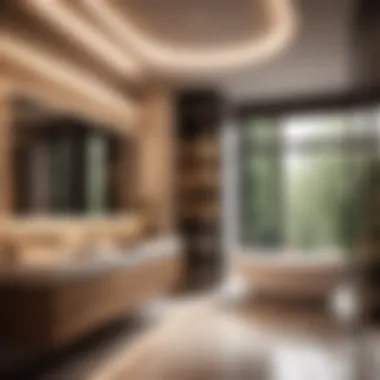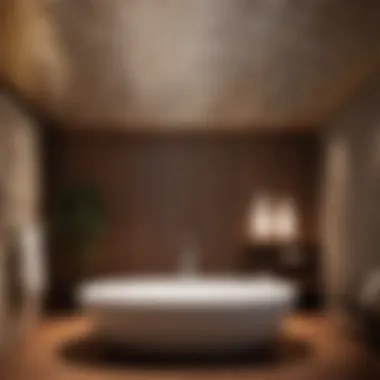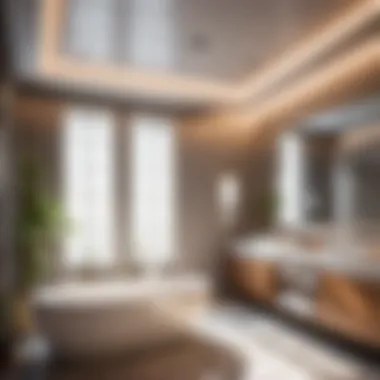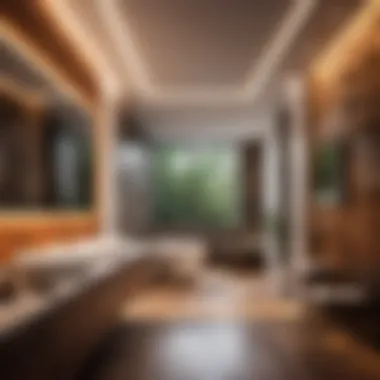Elevate Your Bathroom Design with a Stunning Suspended Ceiling Solution


Materials:
- One box of 2x4 foot suspended ceiling tiles (quantity may vary according to bathroom size)
- Ceiling grid kit including main beams, cross tees, and wall brackets
- Ceiling wire or supporting wires
- Utility knife
- Screwdriver
- Measuring tape
- Pencil
- Safety goggles
- Dust mask
DIY Steps:
- Measure and Plan: Measure your bathroom dimensions to determine the number of ceiling tiles needed. Plan the layout, considering light fixtures and ventilation.
- Prepare the Ceiling: Ensure the ceiling surface is clean and free from any obstacles. Locate and mark joists for attaching the grid.
- Install the Grid: Begin by installing the main beams parallel to the longest wall, securing them to the joists. Insert cross tees at appropriate intervals.
- Cut and Secure Tiles: Measure and cut ceiling tiles as needed to fit at the edges. Insert the tiles into the grid system, ensuring a snug fit.
- Finishing Touches: Adjust any fixtures or tiles for alignment. Secure the tiles in place, ensuring they are evenly spaced and snug within the grid.
Technical Aspects:
- Tools: Ensure you have a utility knife, screwdriver, and measuring tape for precise cuts and placements.
- Timing: Allocate a day for the project, considering drying time for adhesives if needed.
- Techniques: Use safety goggles and a dust mask for protection. Check alignment and level frequently for a professional finish.
DIY Project Process:
- Troubleshooting Tips: If tiles do not fit, re-measure and cut precisely. If grid alignment is off, adjust and secure for a uniform look.
This comprehensive guide outlines the meticulous process of optimizing your bathroom with a suspended ceiling. From meticulous measurements to precise installations, each step contributes to enhancing both the aesthetics and functionality of your space.
Introduction to Bathroom Suspended Ceilings
In this comprehensive guide on optimizing your bathroom space with a suspended ceiling, we delve into the crucial topic of Introduction to Bathroom Suspended Ceilings. Understanding the importance of this element sets the foundation for a successful renovation project. The suspended ceiling concept revolutionizes traditional bathroom design by offering a versatile and practical solution. By exploring this aspect, readers will grasp how suspended ceilings enhance both aesthetics and functionality in a bathroom setting.
Understanding the Concept of Suspended Ceilings
Differences Between Traditional and Suspended Ceilings
Dive into the distinct characteristics that differentiate traditional ceilings from modern suspended ceilings. Traditional ceilings typically involve direct attachment to the structural elements of the building, while suspended ceilings are versatile installations that 'float' below the primary ceiling. The significant advantage of suspended ceilings lies in their adaptability, allowing for easy access to utilities such as wiring or plumbing hidden above. This feature simplifies maintenance and repairs, making them a popular choice for modern bathrooms seeking a balance between convenience and style.
Benefits of Installing a Suspended Ceiling in a Bathroom
Explore the myriad benefits that come with incorporating a suspended ceiling in your bathroom. From improved acoustics to enhanced thermal insulation, these ceilings offer a range of advantages. Additionally, suspended ceilings provide the perfect canvas for incorporating lighting fixtures and ventilation systems seamlessly. Their ability to conceal imperfections or outdated features of the original ceiling adds a layer of customization and elegance to the space. Overall, installing a suspended ceiling in a bathroom not only elevates the visual appeal but also contributes to a more functional and harmonious environment.
Key Considerations Before Installing a Suspended Ceiling
Bathroom Size and Layout
In optimizing your bathroom with a suspended ceiling, factors such as the size and layout play a pivotal role. Understanding the dimensions of the space is essential for determining the most suitable suspended ceiling design. Smaller bathrooms may benefit from lighter-colored ceilings to create an illusion of spaciousness, while larger bathrooms can explore bolder designs for added impact. Considerations regarding the placement of fixtures and other bathroom elements also come into play to ensure a cohesive and balanced aesthetic.


Moisture Resistance
One of the critical considerations before installing a suspended ceiling in a bathroom is its moisture resistance. Due to the high humidity levels typical in bathrooms, the selected ceiling material must possess adequate resistance to prevent warping, mold growth, or other water-related damage. Opt for moisture-resistant materials such as PVC or gypsum board that are specifically designed to withstand bathroom conditions, ensuring longevity and durability for your suspended ceiling.
Lighting Integration
Efficient lighting integration is key to maximizing the functionality and ambiance of your bathroom with a suspended ceiling. Plan ahead for incorporating different lighting options, such as recessed lights or LED strips, to illuminate specific areas or create mood lighting. The suspended ceiling acts as an ideal platform for concealing and arranging lighting fixtures, allowing for a customized lighting scheme that enhances the overall atmosphere of the space. Careful consideration of lighting integration ensures that your bathroom remains both inviting and practical.
Types of Materials for Bathroom Suspended Ceilings
In this comprehensive guide on optimizing your bathroom with a suspended ceiling, the selection of materials holds paramount importance. The choice of materials not only affects the aesthetics but also the durability and functionality of the suspended ceiling. Understanding the different types of materials available for bathroom suspended ceilings is crucial to make an informed decision that aligns with your requirements and preferences.
Gypsum Board Ceilings
Properties and Benefits
Gypsum board ceilings are renowned for their exceptional properties and benefits that make them a popular choice for bathroom suspended ceilings. The key characteristic of gypsum board ceilings lies in their moisture-resistant nature, making them ideal for humid environments like bathrooms. Their ability to withstand moisture helps prevent mold and mildew growth, ensuring a hygienic environment. Additionally, gypsum board ceilings offer easy installation and versatility in terms of finish, allowing for various designs and textures to complement the bathroom decor. While they boast numerous advantages, one potential drawback is their vulnerability to water damage if not properly maintained.
Installation Process
The installation process of gypsum board ceilings contributes significantly to the overall functionality and aesthetics of the bathroom. The key characteristic of this process is the precision required to ensure a seamless finish. Proper installation involves accurate measurements, secure anchoring, and meticulous attention to detail during panel placement. Finishing touches such as sanding, priming, and painting are essential to achieve a polished look. While the installation of gypsum board ceilings may require professional expertise, the end result justifies the effort with its durability and visual appeal.
Metal Ceilings
Durability and Aesthetics
Metal ceilings excel in both durability and aesthetics, making them a preferred choice for modern bathroom designs. The key characteristic of metal ceilings lies in their robust construction, offering long-lasting performance and resistance to damage. Additionally, metal ceilings provide a sleek and contemporary appearance that adds a touch of sophistication to the bathroom interior. Despite their durability and aesthetic charm, one aspect to consider is the potential for scratches or dents over time, requiring regular maintenance to preserve the pristine look.
Cleaning and Maintenance
The cleaning and maintenance of metal ceilings play a vital role in ensuring their longevity and visual appeal in the bathroom. The key characteristic of metal ceilings maintenance is the use of gentle cleaning agents to avoid corrosion or tarnishing. Regular dusting and periodic deep cleaning help retain the shine of metal ceilings. While their durability minimizes the need for frequent repairs, addressing any tarnishing or discoloration promptly can prevent further damage and maintain the metal ceilings' aesthetics.
PVC Ceilings
Waterproofing Features
PVC ceilings are distinguished by their impressive waterproofing features, making them an ideal choice for bathrooms prone to moisture exposure. The key characteristic of PVC ceilings lies in their ability to repel water, preventing water damage and mold growth. This waterproofing property ensures the longevity of the ceiling while maintaining a fresh and hygienic environment in the bathroom. However, it is essential to note that PVC ceilings may have limitations in terms of design versatility compared to other materials.
Design Versatility


Despite some limitations, PVC ceilings offer exceptional design versatility that caters to various aesthetic preferences in bathroom decor. The key characteristic of design versatility in PVC ceilings includes a wide range of colors, patterns, and textures to suit different styles. This flexibility allows homeowners to customize their bathroom ceilings according to their unique tastes and design concepts. While PVC ceilings showcase remarkable design options, careful consideration of the overall aesthetic cohesion with the bathroom space is necessary to achieve a harmonious look.
Installation Process of Bathroom Suspended Ceilings
When it comes to optimizing your bathroom with a suspended ceiling, the installation process plays a crucial role in achieving the desired outcome. Understanding how to properly install a suspended ceiling can significantly enhance both the functionality and aesthetics of your bathroom space. This section will delve into the intricate details of the installation process, highlighting specific elements, benefits, and considerations that are essential for a successful project.
Preparation Steps Before Installation
Measuring and Planning:
Before embarking on the installation of a suspended ceiling in your bathroom, thorough measuring and planning are paramount. Proper measurement ensures accurate sizing of the materials required, while detailed planning helps visualize the final result. One key characteristic of meticulous measuring and planning is the ability to anticipate potential challenges and make necessary adjustments preemptively. This proactive approach not only streamlines the installation process but also minimizes the likelihood of errors, ensuring a seamless outcome.
Choosing the Right Fixtures and Accessories:
Selecting the appropriate fixtures and accessories is another critical aspect of preparing for a suspended ceiling installation. The choice of fixtures and accessories can significantly impact the overall look and functionality of the ceiling. When opting for fixtures and accessories, it is essential to consider factors such as moisture resistance, durability, and aesthetic appeal. By carefully evaluating these aspects, you can ensure that the fixtures and accessories not only complement the suspended ceiling design but also contribute to its longevity and performance.
Step-by-Step Guide to Installing a Suspended Ceiling
Anchor Installation:
Anchor installation is a fundamental step in setting up a suspended ceiling framework. The key characteristic of anchor installation lies in its ability to provide structural support to the ceiling system, ensuring stability and longevity. By securely anchoring the framework to the ceiling joists or existing structure, you create a reliable foundation for the suspended ceiling. This method is a popular choice for its simplicity and effectiveness, making it a valuable component of the installation process.
Panel Placement and Securing:
Placing and securing panels is a meticulous task that requires precision and attention to detail. The key characteristic of panel placement and securing is the seamless integration of panels within the framework, ensuring a uniform and polished appearance. By carefully positioning each panel and securely fastening them in place, you achieve a smooth surface that enhances the overall aesthetics of the bathroom. This approach not only improves the visual appeal but also contributes to the structural integrity of the suspended ceiling.
Finishing Touches:
The final stage of installing a suspended ceiling involves adding finishing touches to complete the project. Whether it's adding trim pieces, applying paint, or incorporating decorative elements, these finishing touches elevate the overall look of the ceiling. One unique feature of finishing touches is their ability to personalize the suspended ceiling, allowing you to infuse your unique style and flair into the bathroom space. By paying attention to these details, you create a cohesive and visually striking suspended ceiling that transforms the ambiance of your bathroom.
Maintenance and Care for Bathroom Suspended Ceilings
In this section, we will delve into the essential aspects of maintenance and care for bathroom suspended ceilings, shedding light on the critical role it plays in preserving the functionality and aesthetics of your bathroom space. Proper maintenance is key to ensuring the longevity and quality of your suspended ceiling.
Cleaning Techniques
Dust Removal
Dust removal is a crucial aspect of maintaining a clean and pristine bathroom suspended ceiling. Regular dusting helps prevent the accumulation of dirt and allergens, creating a healthier indoor environment. The key characteristic of dust removal is its ability to effectively eliminate dust particles from the ceiling surface, promoting better air quality. This cleaning technique is a popular choice for homeowners looking to maintain a hygienic and well-kept bathroom space. Its unique feature lies in its simplicity yet effectiveness in keeping the suspended ceiling looking fresh and inviting.


Stain Treatment
Stain treatment plays a vital role in addressing any unsightly stains that may mar the beauty of your bathroom suspended ceiling. Whether from water damage or other sources, stains can detract from the overall aesthetics of the space. The key characteristic of stain treatment is its ability to effectively remove stubborn stains, restoring the ceiling to its original pristine condition. This cleaning technique is a beneficial choice for this article as it highlights the importance of comprehensive maintenance practices in upkeeping a stylish bathroom. Its unique feature lies in its targeted approach to addressing specific stains, ensuring a spotless and visually appealing suspended ceiling.
Regular Inspection and Repair
Identifying Water Damage
Identifying water damage is crucial in maintaining the structural integrity of your bathroom suspended ceiling. Water damage can lead to mold growth and other issues if left unchecked. The key characteristic of identifying water damage is its early detection capabilities, allowing homeowners to address leaks or moisture issues promptly. This practice is a popular choice for this article as it emphasizes the importance of vigilant maintenance to prevent costly repairs down the line. Its unique feature lies in its ability to pinpoint areas of concern before they escalate into larger problems, preserving the integrity of the suspended ceiling and surrounding elements.
Repairing Minor Damages
Repairing minor damages promptly is essential for prolonging the lifespan of your bathroom suspended ceiling. From small cracks to loose panels, addressing minor issues ensures the ceiling retains its pristine condition. The key characteristic of repairing minor damages is its ability to maintain the overall aesthetics and functionality of the suspended ceiling, preventing further deterioration. This maintenance practice is a beneficial choice for this article as it underscores the significance of regular upkeep in preserving the beauty of your bathroom space. Its unique feature lies in its cost-effective nature, allowing homeowners to address issues early on before they require extensive repairs.
Design Considerations for Bathroom Suspended Ceilings
When it comes to optimizing your bathroom with a suspended ceiling, design considerations play a crucial role in enhancing both the aesthetics and functionality of the space. The choice of color and texture can significantly impact the overall look and feel of the bathroom, making it essential to pay attention to these elements.
Color and Texture Selection
Creating Visual Depth
Creating visual depth is a key aspect when selecting colors and textures for your bathroom suspended ceiling. By carefully choosing hues and finishes that add dimension, you can create a sense of spaciousness and elegance in the room. Opting for lighter shades can make a small bathroom appear larger, while textured finishes can add visual interest and break the monotony of a plain ceiling.
Enhancing the visual depth through color and texture selection not only adds a sophisticated touch to the bathroom but also sets the tone for the entire space. It's important to consider the existing decor and lighting to ensure coherence in the design.
Enhancing Lighting Effects
Choosing the right colors and textures for your suspended ceiling can significantly impact the lighting effects in the bathroom. Light colors reflect natural and artificial light, brightening up the space and making it feel airy and inviting. Conversely, dark colors absorb light, creating a more intimate and cozy ambiance.
By strategically enhancing lighting effects through color and texture selection, you can optimize the illumination in your bathroom, making it both functional and visually appealing. Consider the placement of light fixtures and how different hues interact with light to achieve the desired ambiance.
Incorporating Architectural Features
Integration with Cove Lighting
Integrating your suspended ceiling with cove lighting adds a touch of sophistication and practicality to your bathroom. Cove lighting fixtures can be discreetly incorporated into the ceiling design, providing ambient illumination and accentuating the architectural features of the space.
The key characteristic of integrating cove lighting is the seamless blend of form and function. Not only does it enhance the overall aesthetics of the bathroom, but it also serves a practical purpose by offering soft, indirect lighting that complements other light sources in the room.
Installing Decorative Molding
Installing decorative molding is a timeless architectural feature that can elevate the design of your bathroom suspended ceiling. Molding comes in various styles and profiles, allowing you to customize the look of the ceiling to suit your personal taste and decor scheme.
The unique feature of decorative molding lies in its ability to add architectural interest and refinement to the space. Whether you prefer simple crown molding or intricate designs, molding can transform a plain ceiling into a statement piece, enhancing the overall appeal of your bathroom.







